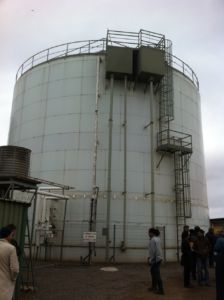Anaerobic Disgestion

The Anaerobic digestion process or AD for short uses micro-organisms to break down organic materials in the absence of oxygen to produce biogas and bioenergy.
Stages of anaerobic digestion
- Hydrolysis – where the organic material is mixed with water and broken down into soluble organic molecules
- Fermentation – where acidogenic bacteria, yeasts and mould convert the molecules into volatile fatty acids (VFA’s)
- Acetogenesis – Acetogens then produce acetic acid, carbon dioxide, ammonia and hydrogen from the VFA’s
- Methanogenesis – methanogens produce methane and carbon dioxide
The Anaerobic Digestion Process
What is biogas?
Biogas is a gas comprised mainly of methane. Methane is highly combustible and can be used for heating, cooling and electrical generation. See below for typical composition of biogas.
- Methane – 50-75%
- Carbon Dioxide – 25-50%
- Nitrogen – 0-10%
- Hydrogen – 0-1%
- Hydrogen Sulphide – 0-3%
- Oxygen – 0-2%
Digestate
Digestate is the by-product of the anaerobic digestion process and is rich in nutrients. Digestate is relatively easy to handle and can be used as a soil conditioner and depending on the nutrient value of the feedstock, used to replace mineral fertilisers.
Conditions for Anaerobic Digestion
Micro-organisms and bacteria involved in the anaerobic digestion process can operate over a wide range of temperatures and conditions however there are some important factors that are important for the anaerobic digestion process to take place.
Temperature
Anaerobic digestion bacteria can be broken down into two main types:
- Mesophilic bacteria – prefer to operate between 20°C and 45°C. Solids content is around 15% and the residence time usually 60-90 days and;
- Thermophilic bacteria – operate at higher temperatures >50°C. Solid content is greater at 20% – 45 % and residence time from 9-45 days
Mesophilic digestion is a more simple method and relies on ambient temperature whereas thermophilic digestion requires the addition of heat. Thermophilic digestion is much more management intensive and the organisms are a lot more sensitive to temperature change. Ideally, micro-organisms prefer to be maintained at an even temperature throughout the year whatever the process.
pH
The ideal PH for anaerobic digestion to take place is 6.8 to 8.5 however as the anaerobic digestion process takes place, the acidity of the substrate (feedstock) increases due to the increase of organic acids, especially in the early stages of the process.
As the process develops more methanogens will be produced and raise the PH however, it needs to be monitored. If the substrate is allowed to become to acid or alkaline the performance of the micro-organisms will decline to a point where methane production stops.
An Oxygen Free Environment
“Anaerobic” is from a Greek word meaning “living without air” and anaerobic organisms will die if oxygen is allowed into the system. Gas tight conditions are essential for anaerobic digestion to take place.
Anaerobic Digestion Reactors
There are three main types of anaerobic digestion reactors.
Complete Mix
Complete mixed digester vessels are insulated and maintained at a constant elevated temperature in the mesophilic or thermophilic range and suitable for wastes with 3-10% solids.
The digester is usually comprised of an insulated tank with mixing and heating ability. A gas tight cover is used to trap the methane or the gas is piped to a storage area. Waste heat can be used to heat water that is circulated throughout the tank in most situations reducing the retention time.
Plug Flow
Plug-flow digesters are a long, rectangular container, often built below-grade, with an airtight, expandable cover. They are suitable for ruminant animal manure with a solids concentration of 10% to 15%.
Plug flow digesters have a waste collection system, an area to mix the manure with water and the digester itself. As material is added to one end of the digester it pushes older manure toward the end of the tank. The gas is captured by the expandable cover. A plug-flow digester requires minimal maintenance.
Covered Lagoons
A covered lagoon anaerobic digester is basically a hole in the ground lined with plastic sheeting that acts as a manure storage area and an airtight cover. The cover traps methane gas produced during decomposition of the manure and a suction pipe extracts the gas for use.
Covered lagoons are a very simple method for recovering energy from manures; they have a low capital cost however they are not very efficient and not suitable for colder environments
Benefits of anaerobic digestion
- Greenhouse gas emission reduction
- Carbon farming
- Energy production
- Fertiliser value of digestate
- Replaces fossil based energy
- Odour suppression
- Vector control
- Weed and pathogen control

